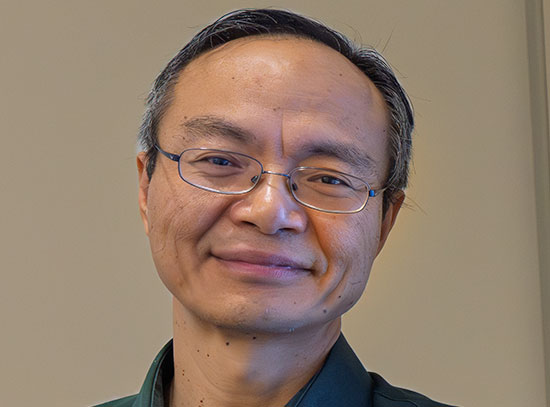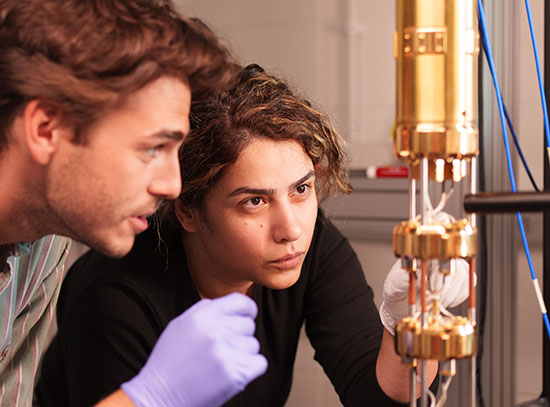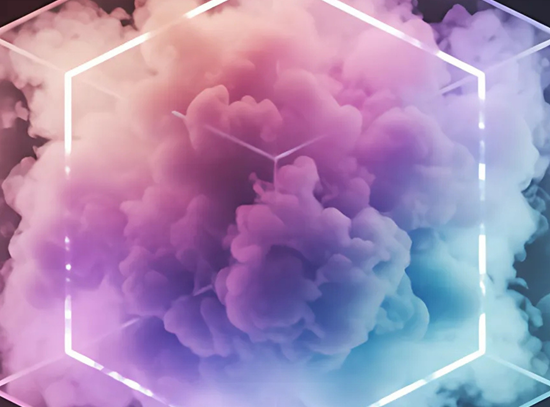Massive Magnets Are on the Move
U.S. national laboratories repurpose electromagnets for innovative research and major cost savings
August 12, 2025
By Sophia Ramirez and Amber Aponte
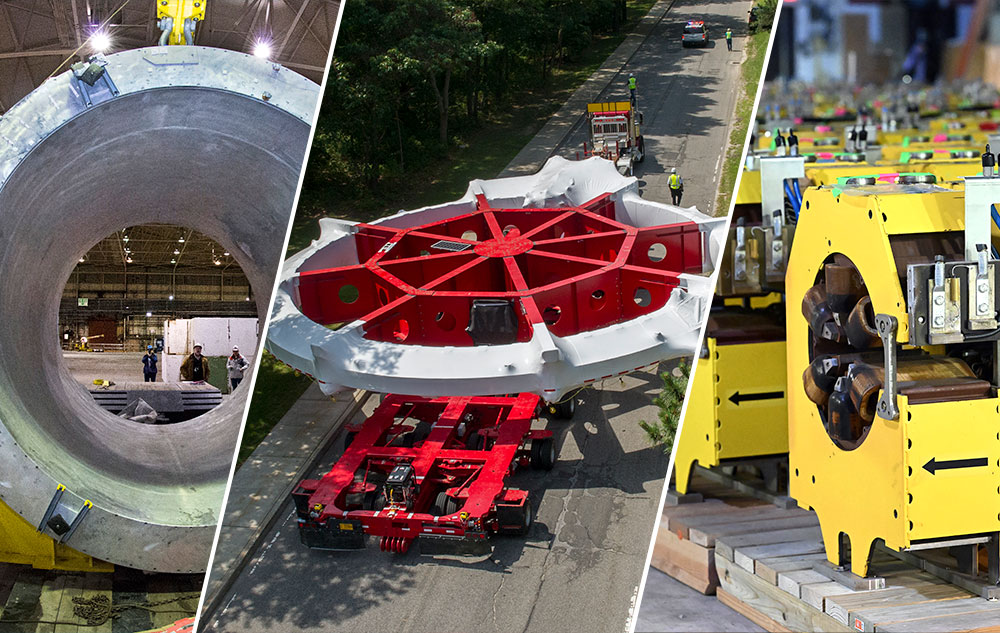 enlarge
enlarge
Left to right: The BaBar solenoid magnet at SLAC National Accelerator Laboratory before its move to Brookhaven. (SLAC) The Muon g-2 storage ring being lifted for transport to Fermi National Accelerator Laboratory in Illinois. (Brookhaven National Laboratory) Magnets from the former Advanced Photon Source at Argonne National Laboratory after arriving at Brookhaven Lab. (Brookhaven National Laboratory)
Plan a route, grab some snacks, and fuel up. Engineers and scientists have been sending massive magnets from U.S. Department of Energy (DOE) national labs on cross-country road trips.
Magnets are at the heart of many scientific instruments at DOE’s Brookhaven National Laboratory. They are not like typical refrigerator magnets, which apply a relatively weak and uniform force to magnetic materials. These electromagnets are often incredibly large and powerful, with variable fields that can be controlled by changing the electric current that runs through them. One of their applications is to apply magnetic force to subatomic particles. For example, the Relativistic Heavy Ion Collider (RHIC) is made of superconducting electromagnets that steer and focus particle beams as they circulate through the accelerator at nearly the speed of light.
To build these magnets from scratch or source brand-new ones, research facilities must make large investments in time and money. Fortunately, when experiments are upgraded or decommissioned, researchers can sometimes reuse magnets for a new purpose. The same electromagnets can be used for decades, placed in upgraded machines to help collect more precise data or even placed in entirely different machines to help carry out a brand-new scientific endeavor.
Big savings on even bigger magnets
After 25 years of groundbreaking nuclear physics research, RHIC is completing its final run this year. Following the final collisions, Brookhaven will begin to transform this DOE Office of Science user facility into the Electron-Ion Collider (EIC), the world’s first collider of its kind.
While the upgrade will reuse much of RHIC’s existing infrastructure — including one of RHIC’s superconducting magnet ion rings — the EIC requires a new electron storage ring. To make that ring, EIC designers need hundreds of electromagnets to steer electrons around the 2.4-mile-circumference tunnel.
Fortunately, in Illinois, at DOE’s Argonne National Laboratory, a DOE Office of Science user facility called the Advanced Photon Source (APS) recently underwent a massive upgrade. Scientists at APS partnered with Brookhaven Lab to repurpose their electromagnets for the EIC. Argonne sent hundreds of their 30-year-old magnets, which are still in their prime and safely usable, to both Brookhaven and DOE’s Thomas Jefferson National Accelerator Laboratory, Brookhaven’s partner in building the EIC.
“It's a noble cause to reuse and repurpose these magnets for many reasons, the most important being cost and schedule savings, as well as not overburdening the world-wide magnet manufacturing base,” said George Mahler, group leader of the EIC Magnet Systems group, who oversees the teams receiving the APS magnets at Brookhaven. “The EIC in its entirety will require approximately 4,000 of these magnets.”
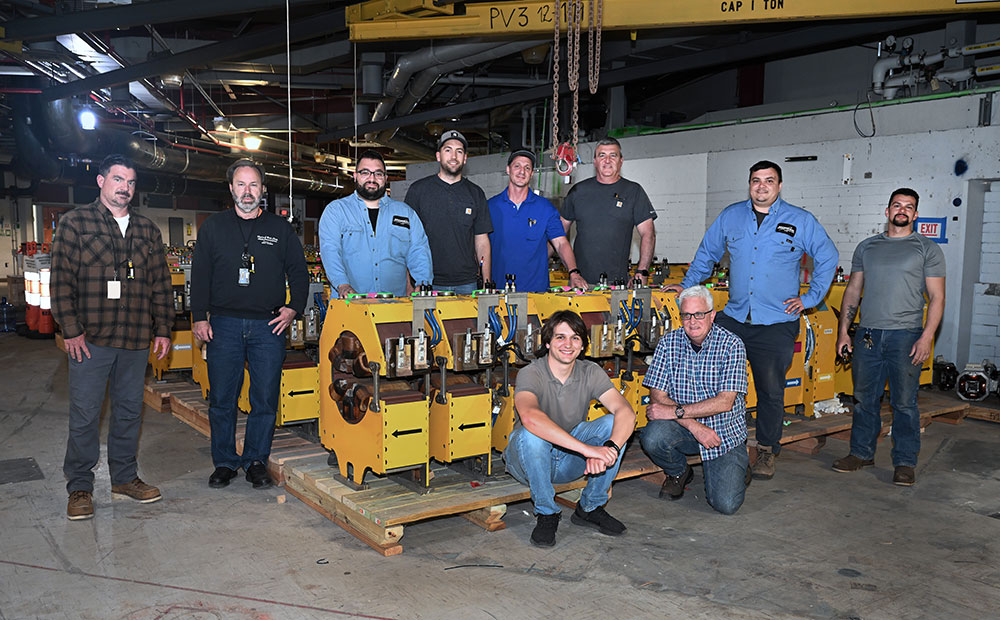 enlarge
enlarge
Brookhaven Lab technicians and engineers pose by magnets transported from the Advanced Photon Source at Argonne National Lab to Brookhaven to be repurposed for the future Electron-Ion Collider. Left to right: Rob Karl, Clinton Bedell, Travis Herbst, Cory Hanson, Matthew Milidantri, Michael Hamilton, Adrian Timon, Nick Lupinacci. Front Row: Jay Best, George Mahler. (Kevin Coughlin/Brookhaven National Laboratory)
Mahler estimates that a brand-new sextupole magnet, one kind of magnet that makes up the electron storage ring, can cost up to $60,000. Sextouple magnets are named for their six inner magnetic poles, which correct focusing errors as the electron beams zip around the storage ring. Brookhaven Lab received about 360 quadrupole and sextupole magnets from APS in total, worth about $21 million.
In addition to reusing magnets, the EIC project will recycle or sell unused materials, such as copper, aluminum, and other metals, for scrap, which will save an additional $600,000.
Recycling magnets for major physics experiments isn’t a new idea for Brookhaven. The Lab has a long history of saving years and millions of dollars by repurposing valuable instrumentation.
At RHIC, the former PHENIX detector was upgraded to create the sPHENIX experiment, which began operations in 2023. Among other updates, adding a new solenoid magnet enabled physicists to collect more precise measurements of particle collisions. And while the magnet provided new opportunities for Brookhaven, the magnet itself was not new at all.
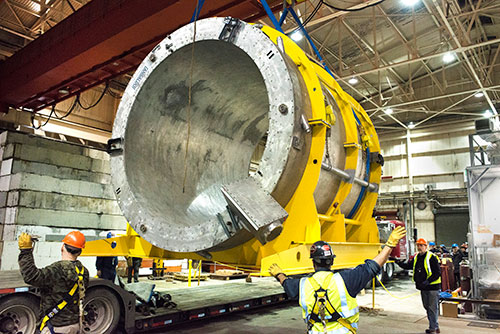 enlarge
enlarge
Technicians guide the BaBar solenoid magnet into a high-bay testing area within Brookhaven Lab's Superconducting Magnet Division after it arrived from SLAC National Accelerator Laboratory in California in 2015. (Brookhaven National Laboratory)
It came from DOE’s SLAC National Accelerator Laboratory in California, from the the BaBar experiment that was decommissioned in 2008. This solenoid is a 30,000-pound donut-shaped magnet large enough for an elephant to walk through. The sPHENIX team had the right timing to propose taking over the solenoid in 2013, even before the transition from PHENIX to sPHENIX began.
Brookhaven and DOE estimated the superconducting solenoid magnet was worth approximately $12 million, even after 30 years of use. Producing a new magnet would have cost significantly more.
“DOE helped us very efficiently transfer ownership. They were clearly enthusiastic about the possibility of us reusing the magnet,” said John Haggerty, who served as the sPHENIX project scientist during construction. “It arrived on a snowy night, but I still tracked the truck and jumped in my car to see it reach the main gate.”
Trucks, traffic, and boats — oh my!
Just this past June, another mega magnet that had made a cross-country journey was in the news. That’s when DOE’s Fermi National Accelerator Laboratory made headlines for releasing the most precise measurement of the muon magnetic anomaly. The 17-ton electromagnet storage ring that made this research possible started its scientific life 25 years ago in an earlier “muon g-2” experiment at Brookhaven Lab. The Brookhaven experiment found strong hints of an exciting new discovery. Those hints motivated the idea to move the ring to Fermilab to repeat the experiment with a more powerful muon-generating beam.
A team of scientists and engineers from both Brookhaven Lab and Fermilab then faced a puzzle: how to get a 50-foot-diameter magnet ring from Long Island to Illinois.
“The Fermilab collaboration looked at the Brookhaven results and estimated they could get 20 times more muons,” explained physicist Bill Morse, who oversaw the team of physicists that coordinated “the Big Move.” The upgraded experiment could yield an even clearer picture of the basic building blocks of the universe, but it required some clever engineering to move the experiment.
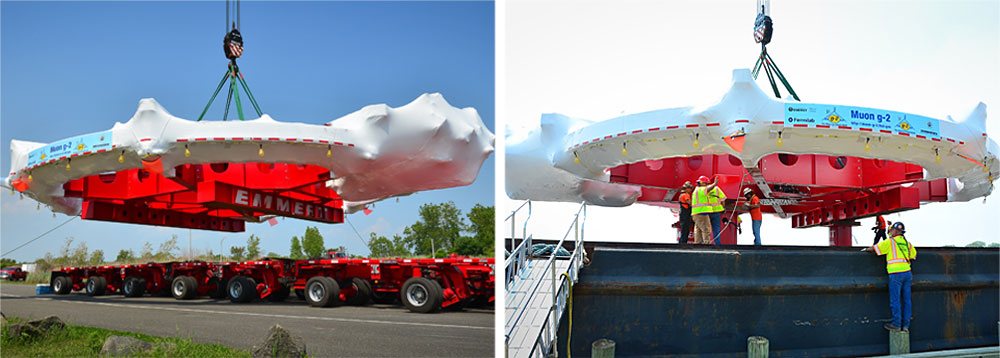 enlarge
enlarge
A crane lifted the Muon g-2 storage ring onto a truck for its cross-country trip in 2013. (Brookhaven National Laboratory)
The team of Brookhaven physicists and engineers devised the most efficient and least risky route for the ring. They contracted a transportation company to load the magnet onto a truck and drive it to Smith Point Marina. For the average beachgoer, that is a 10-mile, straight shot down William Floyd Parkway. For the magnet truck, this easy drive required working with the local authorities to control traffic and make room for the magnet.
“We had to close down William Floyd Parkway because the ring took up all the lanes,” said Morse.
The Muon g-2 ring completed its 3,200-mile journey from Brookhaven Lab to Fermilab on July 26, 2013. This video celebrates the 12-year anniversary of the journey's completion. (David Rahner/Brookhaven National Laboratory)
After the first leg of the trip by truck, the magnet took a boat cruise south down the East Coast, around Florida, and up the Mississippi river. Then, under Fermilab’s care, the magnet was driven across Illinois over three nights, while parked in various supermarket parking lots during the day. Fermilab took advantage of this moving science museum and coordinated with local schools to visit the magnet and learn about the experiment along the way.
Testing magnets at their new destination
For each of these magnet moves, DOE’s national lab scientists and contractors calculated the long routes to protect the magnets and cause as little disruption to traffic as possible, paying careful attention to safety. After each magnet’s cross-country trip, teams subjected the cargo to rigorous testing to ensure all components worked after being jostled in trucks and boats.
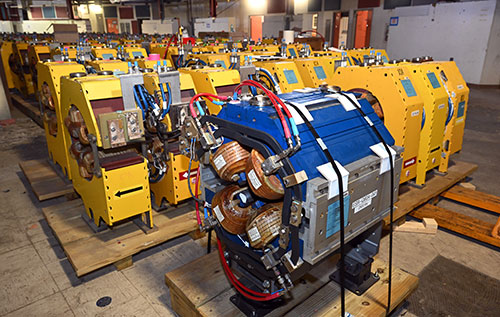 enlarge
enlarge
The APS magnets after arriving at Brookhaven Lab in 2024 are currently housed in building 725 for testing. (Kevin Coughlin/Brookhaven National Laboratory)
For example, when magnet technicians at Brookhaven Lab received dozens of APS magnets for the EIC ring, they had to replace aged components, check for water leaks via pressure and flow tests, conduct high voltage testing of the electromagnets’ coil assemblies, produce new components, and reconfigure outdated designs. Magnet engineers and physicists are still working to verify magnetic field measurements and adequacy of the magnets.
Engineers worked with a host of professionals to clear the magnets for reuse. Radiological safety teams assessed metal holding structures, beam equipment services aided disassembly work, and riggers carefully moved and placed the ton-heavy magnets.
Before physicists and engineers could deem the BaBar magnet ready to be the central component of the new sPHENIX detector, they ran it through a “full field test” — ramping it up to full power to make sure it could safely produce a high-quality magnetic field.
“We had to build a steel box that could surround the magnet and contain its power during the test,” said Haggerty. “We ramped up the field all the way.”
Just like the APS magnet upgrade, Haggerty’s team depended on expertise from across the Lab and external partners to carry out the test. The Collider-Accelerator Department designed the steel box, the cooling system, and the power supplies for the magnet, while the Superconducting Magnet Division modified the solenoid for use in sPHENIX and developed controls and monitoring for the full field test.
The sPHENIX team also worked with a group that traveled to Brookhaven from CERN, the European Organization for Nuclear Research, to map the magnetic field before the rest of the sPHENIX detector components were built within and around the magnet. The sPHENIX team recently published their first physics results from data collected when the full detector became operational starting in 2023.
The magnets at the heart of sPHENIX experiment, in the Muon g-2 storage ring, and destined for the EIC would have been incredibly expensive and time consuming to reproduce from scratch. It is no wonder that labs are jumping at the chance to repurpose these magnets for brand new experiments at the cutting edge of science.
In the coming years, there may be even more cross-country road trips to build the scientific instruments of the future.
Brookhaven National Laboratory is supported by the Office of Science of the U.S. Department of Energy. The Office of Science is the single largest supporter of basic research in the physical sciences in the United States and is working to address some of the most pressing challenges of our time. For more information, visit science.energy.gov.
Follow @BrookhavenLab on social media. Find us on Instagram, LinkedIn, X, and Facebook.
2025-22523 | INT/EXT | Newsroom




